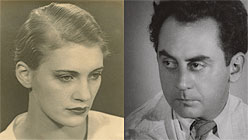The story of Man Ray and Elizabeth “Lee” Miller is a love story. It is not a happily-ever-after story, but one of obsession, inspiration, anxiety, and defeat. Theirs is a story of two incredibly talented artists and their combined ability to both create and destroy.
If this all sounds a bit melodramatic, that’s the hook the Legion of Honor is going for in their exhibition Man Ray | Lee Miller, Partners in Surrealism. Organized and first shown by the Peabody Essex Museum in Salem, Massachusetts, the exhibition looks at the two artists before, during, and after their tumultuous relationship.
According to Partners in Surrealism, Miller’s bewitching looks were the central tension in her life and relationships. In 1929, after modeling work in New York dried up, photographer Edward Steichen recommended Miller seek out Man Ray as a mentor. Her apprenticeship with him quickly morphed into a romance. She became both a photographer and the photographic subject of Ray’s practice.

Man Ray, Lee Miller, ca. 1930; c. The Artists Estate 2010. All rights reserved. The Penrose Collection.In 1941 she would say, “I would rather take a picture than be one,” but that time had not yet come. For the three years of their relationship, Miller’s body served as the inspiration for many of Ray’s most iconic images. Shadow Patterns on Lee Miller’s Torso (1930) is strategically cropped to cut Miller off at the head and the hips, leaving her chest exposed, her body fragmented.
Miller herself was steeped in Surrealist thought, seeking in her own photographs to make the familiar unfamiliar. Unlike Ray, who kept mostly to his studio, Miller roamed the streets of Paris, finding surreal juxtapositions readymade in reality. Her photographs are strikingly high contrast, geometric compositions: Parisian architecture is rendered uncanny.





